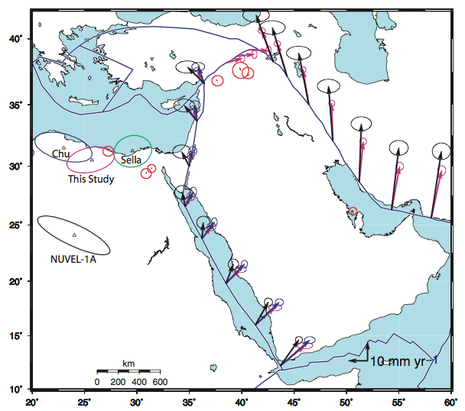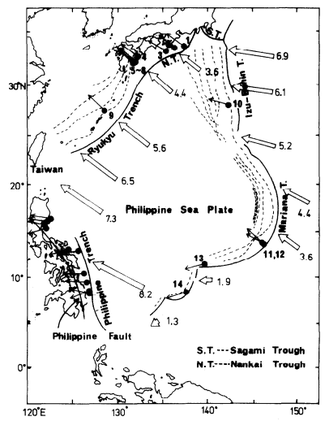Future Tectonics
The Eurasian tectonic plate is one of the largest on Earth, spanning all of Asia and Europe. Though complex, the active tectonics along the borders of the plate can be roughly summarized by divergent boundaries to the west/northwest, and convergent boundaries to the east/southeast. The general motion of the Eurasian plate is west/southwest. The southern and eastern boundaries of the Eurasian plate are the most tectonically active. Along the southern border the Indian and Arabian plates are colliding with the Eurasian plate, and along the eastern border the Philippine Sea plate is being subducted.
 Pierre Dèzes (1999; Institut de Mineralogie et Petrographie, Université de Lausanne)
Pierre Dèzes (1999; Institut de Mineralogie et Petrographie, Université de Lausanne)
Indian-Eurasian Plate Interaction
Approximately ~45-50 million years ago, the Indian plate, drifting north at a rate of ~15 cm/yr, collided with the Eurasian plate. Upon colliding with the Eurasian plate the Indian plate velocity slowed to a rate of ~4 cm/yr and began uplifting the current Himalayan Mountains [1]. Currently the Indian plate continues to move north into the Eurasian plate at ~4-5 cm/yr [2], and the Himalayas are being uplifted at ~10 mm/yr – 30 mm/yr [3]. Over millions of years the Indian plate will likely continue to converge inland of the Eurasian plate and uplift the Himalayan Mountains further. Extrapolating from the abrupt decrease in velocity of the Indian plate after colliding with the Eurasia plate, the velocity of the India-Eurasia plate boundary may further decrease and eventually halt.
Approximately ~45-50 million years ago, the Indian plate, drifting north at a rate of ~15 cm/yr, collided with the Eurasian plate. Upon colliding with the Eurasian plate the Indian plate velocity slowed to a rate of ~4 cm/yr and began uplifting the current Himalayan Mountains [1]. Currently the Indian plate continues to move north into the Eurasian plate at ~4-5 cm/yr [2], and the Himalayas are being uplifted at ~10 mm/yr – 30 mm/yr [3]. Over millions of years the Indian plate will likely continue to converge inland of the Eurasian plate and uplift the Himalayan Mountains further. Extrapolating from the abrupt decrease in velocity of the Indian plate after colliding with the Eurasia plate, the velocity of the India-Eurasia plate boundary may further decrease and eventually halt.
 [4]
[4]
Arabian-Eurasian Plate Interaction
The Arabian plate is currently drifting north and colliding with the Eurasian plate. As shown by the adjacent diagram, the Arabian plate is rotating counter-clockwise, converging with the Eurasian plate at a rate of ~20 mm/yr – 30 mm/yr and rifting from the African plate in the Red Sea at a rate of ~10 mm/yr [4]. Based on this current motion I predict that over the course of the next 10-100 million years, the collision between the Arabian and Eurasian plate will close off and potentially eliminate the Persian Gulf. All the while the simultaneously Red Sea will become wider.
The Arabian plate is currently drifting north and colliding with the Eurasian plate. As shown by the adjacent diagram, the Arabian plate is rotating counter-clockwise, converging with the Eurasian plate at a rate of ~20 mm/yr – 30 mm/yr and rifting from the African plate in the Red Sea at a rate of ~10 mm/yr [4]. Based on this current motion I predict that over the course of the next 10-100 million years, the collision between the Arabian and Eurasian plate will close off and potentially eliminate the Persian Gulf. All the while the simultaneously Red Sea will become wider.
 [4]
[4]
Aegean and Anatolian – Eurasian Interaction
The Aegean and Anatolian plates, located above Egypt on the north end of the Mediterranean Sea on the plates, are considered microplates of the main Eurasian plate. Relative to the Eurasian plate, the Anatolian plate is moving west and the Aegean plate is moving southwest [4]. The north borders of these plates where they contact the Eurasian plate can be described as a continental transform boundary, moving west at ~20 mm/yr relative to the Eurasian plate [4]. On the southern border of the Aegean plate, the African plate is being subducted at a rate of ~35 mm/yr, and on the southern border of the Anatolian plate the African plate is being subducted at a rate of ~10 mm/yr [4]. Based on these boundaries and the counter-clockwise rotation of both the Aegean and Anatolian plates, I predict that over millions of years the Mediterranean sea will narrow as the African plate continues to subduct under the microplates. Additionally, I predict that the Aegean Sea will begin to close as the Anatolian plate continues to move westward and the Aegean plate moves southwestward.
The Aegean and Anatolian plates, located above Egypt on the north end of the Mediterranean Sea on the plates, are considered microplates of the main Eurasian plate. Relative to the Eurasian plate, the Anatolian plate is moving west and the Aegean plate is moving southwest [4]. The north borders of these plates where they contact the Eurasian plate can be described as a continental transform boundary, moving west at ~20 mm/yr relative to the Eurasian plate [4]. On the southern border of the Aegean plate, the African plate is being subducted at a rate of ~35 mm/yr, and on the southern border of the Anatolian plate the African plate is being subducted at a rate of ~10 mm/yr [4]. Based on these boundaries and the counter-clockwise rotation of both the Aegean and Anatolian plates, I predict that over millions of years the Mediterranean sea will narrow as the African plate continues to subduct under the microplates. Additionally, I predict that the Aegean Sea will begin to close as the Anatolian plate continues to move westward and the Aegean plate moves southwestward.
Philippine Sea Plate - Eurasian Plate Interaction
On the southeastern border of the Eurasian plate, along the Nankai Trough, the Philippine Sea plate is being subducted beneath the Amur plate, a microplate of the main Eurasian plate. The Philippine Sea plate is drifting northwest relative to the EU plate [6], subducting under the Amur plate and adjacent Okinawa plate at a rate of ~55 mm/yr and ~75 mm/yr, respectively [5]. On the eastern border of the Philippine Sea plate, the North American plate is being subducted [5]. Because the Philippine Sea plate is being subducted beneath the Amur plate and Okinawa plate with no new crust being formed along its other boundaries, I predict that over millions of years it may be completely subducted.
Bibliography
1.
Copley, A., J. -P Avouac, and J. -Y Royer. "India-Asia Collision and the Cenozoic Slowdown of the Indian Plate: Implications for the Forces Driving Plate Motions." Journal of Geophysical Research B: Solid Earth 115.3 (2010)SCOPUS. Web. 30 Jan. 2014.
2.
Kumar, P., et al. "The Rapid Drift of the Indian Tectonic Plate." Nature 449.7164 (2007): 894-7. SCOPUS. Web. 30 Jan. 2014.
3.
Xu, C., et al. "GPS Measurements of Present-Day Uplift in the Southern Tibet." Earth, Planets and Space 52.10 (2000): 735-9. SCOPUS. Web. 30 Jan. 2014.
4.
McClusky, S., et al. "GPS Constraints on Africa (Nubia) and Arabia Plate Motions." Geophysical Journal International 155.1 (2003): 126-38. SCOPUS. Web. 30 Jan. 2014.
5.
Bird, P. "An Updated Digital Model of Plate Boundaries." Geochemistry, Geophysics, Geosystems 4.3 (2003)SCOPUS. Web. 30 Jan. 2014.
6.
Seno, T. "The Instantaneous Rotation Vector of the Philippine Sea Plate Relative to the Eurasian Plate." Tectonophysics 42.2-4 (1977): 209-26. SCOPUS. Web. 30 Jan. 2014.
1.
Copley, A., J. -P Avouac, and J. -Y Royer. "India-Asia Collision and the Cenozoic Slowdown of the Indian Plate: Implications for the Forces Driving Plate Motions." Journal of Geophysical Research B: Solid Earth 115.3 (2010)SCOPUS. Web. 30 Jan. 2014.
2.
Kumar, P., et al. "The Rapid Drift of the Indian Tectonic Plate." Nature 449.7164 (2007): 894-7. SCOPUS. Web. 30 Jan. 2014.
3.
Xu, C., et al. "GPS Measurements of Present-Day Uplift in the Southern Tibet." Earth, Planets and Space 52.10 (2000): 735-9. SCOPUS. Web. 30 Jan. 2014.
4.
McClusky, S., et al. "GPS Constraints on Africa (Nubia) and Arabia Plate Motions." Geophysical Journal International 155.1 (2003): 126-38. SCOPUS. Web. 30 Jan. 2014.
5.
Bird, P. "An Updated Digital Model of Plate Boundaries." Geochemistry, Geophysics, Geosystems 4.3 (2003)SCOPUS. Web. 30 Jan. 2014.
6.
Seno, T. "The Instantaneous Rotation Vector of the Philippine Sea Plate Relative to the Eurasian Plate." Tectonophysics 42.2-4 (1977): 209-26. SCOPUS. Web. 30 Jan. 2014.
Created by: Daniel Hardwick


